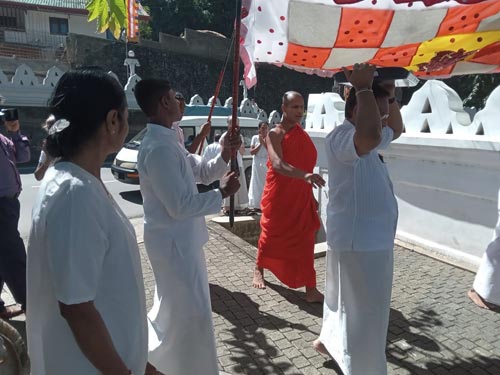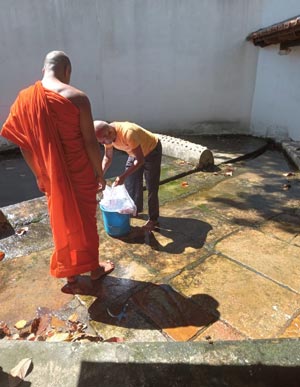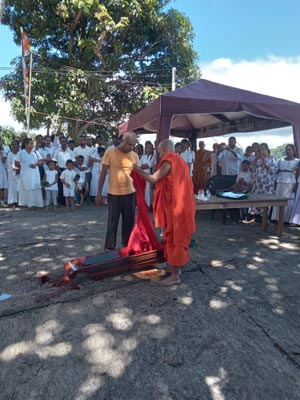Age-old traditions of the Katina cheevara poojava at Malwatte Viharaya

Taking the cloth to be washed
The three months of vassana (rains retreat) for monks in their temples ended with the Vap Full Moon Poya on October 28. From the day after this Poya, the Katina Cheevara Masaya (month of robes) began and will end with Il Poya on November 26. Each viharaya (temple) decides on the day they should conduct the Katina cheevara poojava.
The Sunday Times visited the Malwatu Maha Viharaya in Kandy on November 11 to observe and be a part of the Katina cheevara poojava – the ceremony where robes are offered to monks after the vas retreat.
Malwatu Vihara Vaasi Karmacharya Digana Alutwatte Sri Priyadarshanaramaya Pallekotuwa Sadham Vehera Viharadhipathy, Ven. Ambanthalawe Sarankara Thera organised the Katina pinkama in the Thumpane viharaya at Malwatte Temple, with the assistance of the dayaka-dayika of the temple.
There are many age-old rituals to be performed during the Katina cheevara month. On November 10, a pirith ceremony was held at the Talwatte residence in Ampitiya where the Katina cloth to be made into a robe was placed. The Katina cloth is cut into five pieces resembling a paddy field with niyara (ridges) and stitched together. This is done to get rid of thanha (craving) and also to discourage people from stealing it – as no one would want to steal such a patched robe.

Washing the cloth at the well
At dawn on November 11, the Katina cloth was taken to the Malwatte Viharaya in a perahera (procession) by the. Talwatte family who played a major role in this year’s Katina pinkama. Family members, friends and devotees in turn carried the cheevara placed on a tray above their heads, passing it on to other devotees who joined the procession to reach the Malwatte temple. On their way, the Principal of Mahamaya Girls’ College Kandy and students joined in with another katina cheevara cloth to be taken to the temple. They came down from Mahamaya Mawatha in a perahera with whip crackers, drummers, dancers and a caparisoned tusker to join the first group and proceeded to the Malwatte temple.
In the late morning the two cheevara cloths were taken in procession to the well near the Kandy Lake just below the Malwatte temple. This ritual is connected with the ancient practice in India when the cloth of a corpse was taken from a rubbish heap and had to be washed before a robe was made. The Katina cheevara is prepared and presented within 12 hours. The two cloths were washed and taken back to the temple. The white cloths were placed in the pandu oruwa to be dyed, which is known as ‘pandu gasanawa’. Ven Ambanthalawe Saranankara Thera with the help of a devotee dyed the two Katina cheevara in the pandu oruwa. Hevisi drumming continued when each ritual was performed.
During the Buddha’s time the pandu was prepared from the bark of trees which was boiled to extract the juice to dye the robes. This practice was continued for a long time. But in this modern age, a powdered dye is used to stain the cloth. Yet, there are some temples in villages that still use the bark of trees to stain the robes. A daval danaya (alms giving) was organised for 50 monks. After the alms giving the monks chanted pirith where the devotees listened with rapt attention.
Only upasampada (high ordained) monks were permitted to remain in the hall for the presentation of the Katina cheevara ceremony – samanera (novice) monks were requested to leave the hall. The Most Ven. Dimbulkumbure Sri Sarankara Wimaladhamma Anunayaka Thera of the Malwatte Chapter delivered a discourse. Two Upasampada (high ordained) monks who had observed the vassana retreat were named to receive the katina cheevara and the robes were draped on them.

Dyeing the cloth
Once this ritual was over, the Malwatu Karaka Sangha Sabhika, Anuradhapura Vishvavidyala Kathikacharya Ven. Weliwita Soratha Thera delivered the final discourse on the Katina cheevara ritual which was practised from the time of the Buddha. This was when 30 monks visited the Buddha after the rains retreat. When they arrived at Jetawanaramaya, they were drenched due to the heavy rains. Realizing the difficulties the monks had to undergo, the Buddha recommended an additional robe for monks other than the three robes (thun sivura), used by the monks.
A monk who receives the Katina cheevara has five privileges for the next five months. He is not required to inform anyone when he leaves the pansala, can possess any number of robes, all the sangika pirikara can be kept for himself whereas the other monks have to distribute them, he can request for pirikara, can wear the andana and one other robe (others have to wear the thun sivura – andana, thanipata sivura and depata sivura).
A ’kapruka’, a branch of a Jak tree, was placed in one corner in the hall where devotees placed their offerings for the use of monks.
A monk’s seniority is judged by the number of vas seasons he has spent after upasampada (high ordination).
Buddhist devotees believe the offering of a Katina cheevara will help them accrue great merit and shorten their samsaric sojourn.
Searching for an ideal partner? Find your soul mate on Hitad.lk, Sri Lanka's favourite marriage proposals page. With Hitad.lk matrimonial advertisements you have access to thousands of ads from potential suitors who are looking for someone just like you.


